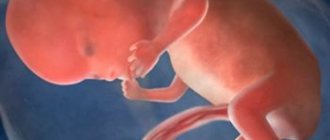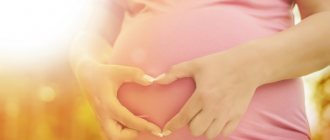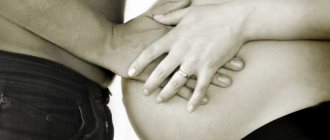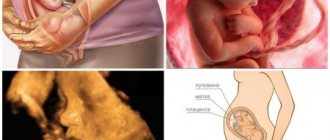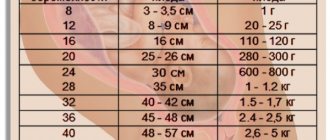Fetal development at 34 weeks of gestation
Fruit size:
44 cm
Fruit weight:
2 kg.
The 34th obstetric week of pregnancy is the end of the 8th month of pregnancy (34 weeks = 7 months and 28 days or 238 days of pregnancy). You are in the last, third trimester, and at 32 embryonic weeks. With the start of the 34th week of pregnancy, childbirth is getting closer. From the beginning of this period, a woman should be especially attentive to her well-being and respond to any dubious sensations or behavior of the baby in the stomach.
Weight, height and development of the fetus at 34 weeks
The development of the fetus is completed, its weight at 34 weeks already reaches 2 kg, and its height is 44 cm. Your baby weighs the same as a melon.
At this time, the fetus is already developed. There are cases when women give birth at this stage, and the child born is not considered premature, but born prematurely. He is quite viable, can breathe on his own and does not need special care.
At 34 weeks of pregnancy, the amount of lubricant that covers the baby's body increases. Now it protects him from the effects of amniotic fluid, and in the future it will help him pass through the birth canal more easily.
Externally, the fetus is already almost perfect, individual features have appeared on the face, the ears have almost formed and moved away from the head. The heart beats 2 times faster than that of a normal person and can be easily heard with a stethoscope. The frequency is approximately 130 beats per minute.
At this stage of pregnancy, the baby's hair begins to grow, replacing the fluff. The baby needs calcium, which he should receive from his mother. By the 34th week of pregnancy, the baby becomes large, and its movements are limited by the placenta. Changes in the baby's behavior are noticeable, but you should not be afraid of a decrease in his activity.
Fetal movements at this stage become smoother. A pregnant woman should listen to the movements of her baby; they should be regular and daily, although not as active as in earlier stages.
The baby's adrenal glands work at full strength and produce the hormone that the female body needs to begin lactation. Now there is 10 times more of it in the baby’s body than in an adult. The size of the adrenal glands is also increased, but after birth they noticeably decrease. Every day, the child secretes approximately half a liter of urine into the amniotic fluid, which is constantly renewed.
At this stage, the baby should already be in a head-down position, directly above the birth canal. This option is considered the safest for childbirth. But there are also other variants of presentation, for example, breech (it occurs in 3.5% of cases). In this position, the baby's legs and butt are above the birth canal. It is also rare, but still possible to encounter oblique and even transverse presentation. In this case, the woman will most likely be given a caesarean section.
Pain
Pain at 34 weeks of pregnancy, manifested in the abdomen, lower back, and back, in most cases is classified as normal. They are explained by the constantly enlarging uterus and growing abdomen, which contribute to a shift in the center of gravity. And also by the gradual softening of the supporting ligaments and joints under the influence of certain hormones: the mother’s body prepares for childbirth and does everything possible to facilitate the passage of the baby through the birth canal. Hence the pain at 34 weeks of pregnancy not only in the abdomen and lower back, but also in the pubic area, in the sacrum, and thighs. Nagging pain, similar to menstrual pain, may appear in the abdomen.
However, it should also be taken into account that abdominal and lower back pain may also indicate a high risk of preterm birth. Therefore, if pain at 34 weeks of pregnancy is not a temporary phenomenon and does not go away for some time, and even appears when it did not make itself felt in the previous weeks, it is still worth seeing a doctor. The likelihood of premature birth, in addition to pain in the abdomen and lower back, will also be indicated by prolapse of the abdomen, involuntary bowel movements, passage of a plug, rupture of amniotic fluid, and increased frequency of uterine contractions that become regular.
By the way, about contractions of the uterus: it can also contract as a “training” before childbirth - in this case we are talking about Braxton-Higgs contractions (they are also often called “Braxtons”). At 34 weeks of pregnancy, training contractions may be painful, but they are irregular in nature, starting in the upper part of the uterus, gradually moving to the bottom, after which the pain goes away. If contractions at the 34th week of pregnancy become regular, cause noticeable pain and are accompanied by other unambiguous signs of the onset of labor (rupture of water, rupture of the plug), you should immediately call an ambulance.
Some swelling is also possible at 34 weeks of pregnancy: slight swelling of the face, hands, feet or ankles plagues almost every pregnant woman. But if the swelling does not go away for more than a day, and is also localized in the abdominal wall, on the legs, you should see a doctor: such swelling may indicate dropsy in pregnancy.
Weight
To avoid edema, it is also necessary to eat rationally and carefully monitor weight gain. Thus, weight at 34 weeks of pregnancy can already exceed the initial one by 11-12 kg. Moreover, from this time on, weight gain may slow down somewhat. It should be remembered that weight control in the last week of pregnancy is one of the priorities. So, if you exceed the norm in terms of gaining kilograms, you should choose a suitable diet that allows you to “control” your weight. Its main condition is limiting the consumption of easily digestible carbohydrates and fats.
What happens to a pregnant woman’s body at 34 weeks?
During this period, expectant mothers become distracted and self-absorbed. Anxiety often manifests itself, worries and fears associated with the upcoming birth appear. Now it is important for you to carefully monitor your well-being and mood, avoid physical activity, stress and worry about little things. Although the 34th week is not a good time for long trips, you should not completely give up walking in the fresh air or any physical activity. It is important for you and your baby to get enough oxygen, and moderate physical activity will help you cope better with childbirth.
The stomach becomes heavier and this makes it difficult to climb stairs, move around the house, and even find a comfortable position for resting and sleeping. Special pillows for pregnant women will help to cope with the last problem.
“Training” contractions are felt more and more often. Your calves may experience cramps that will bother you mainly at night. During fetal activity, the stomach does not pull so much. Pay attention to your legs, arms and abdomen, because swelling is possible, which are signs of dropsy in pregnant women.
You may also be “visited” by pain in the back, abdomen and lower back, the reason for this is the growth of the abdomen and enlargement of the uterus. At this time, the body begins to produce a large amount of hormones that help soften some ligaments.
Urination becomes more frequent as the fetus puts pressure on the bladder. The abdomen lowers as your unborn baby moves into the pelvis and into the birthing position.
Closely monitor natural vaginal discharge. Particular attention should be paid to thin, watery discharge. This means that you may experience premature labor, which is highly undesirable, because it is too early to give birth at this stage.
Changes in the body of the expectant mother
In the middle of the third trimester, the pregnant woman’s body begins active preparation for the upcoming birth. At this time, the baby continues to grow, but there is less and less free space left for his active movements, which can cause inconvenience and even pain to the expectant mother.
By the 34th week of pregnancy, a woman should be prepared for the following changes in the body:
- Weight gain. A woman gains 10–12 kg of her pre-pregnancy body weight, which is normal. However, it must be remembered that extra pounds can cause complications during childbirth. To avoid this, you must adhere to a diet prepared together with a gynecologist.
- Belly growth. This means that the child is developing well and receives all the necessary microelements.
- Enlarged uterus. Its size can reach up to 32 cm, and its weight can reach up to 1 kg. The fundus of the uterus during this period is located almost at the highest point, under the woman’s ribs, but closer to childbirth the uterus will begin to descend.
By the 34th week of pregnancy, the uterus increases to 32 cm, and its bottom is located under the woman’s ribs - The appearance of colostrum. As a result of the work of placental hormones, the mammary glands begin to produce milk. But do not be upset if colostrum is not released at this time. This process is individual in nature and can begin closer to childbirth or even after it.
By the beginning of the ninth month of my pregnancy, I had gained 20 kg. It was very difficult to walk and I suffered from shortness of breath. The birth went without complications, but my knees still hurt after such a weight jump, even now that my daughter is already 6 years old. After giving birth, my body weight decreased by half, and I had to remove the remaining 10 kg with hard training. Only two years after the birth of the baby I returned to my form.
Ailments that a pregnant woman may encounter
By the 34th week of pregnancy, a woman no longer feels as comfortable as before: heartburn occurs, fatigue occurs, it becomes difficult to walk, and swelling appears.
At this stage, a woman may encounter such unpleasant pregnancy complications as:
- Discharge. If they are moderate and light in color, then there is no reason to worry. You should consult a doctor if the discharge:
- curdled and mucous, gray-green, yellow or brown in color and have an unpleasant odor - an infection may have entered the body;
- with blood particles - this is one of the signs of placental abruption, as well as a harbinger of premature birth;
- liquid, odorless and colorless - probably leakage of amniotic fluid;
- with pieces of dense mucus - may indicate that the mucus plug has begun to come off.
- Stretch marks or stretch marks. Their appearance is due to the fact that a woman gains weight, her stomach grows, and the skin does not always keep up with this process. Special creams and oils, proper nutrition and weight control will help you cope with stretch marks.
During pregnancy, stretch marks often appear on a woman’s abdomen, since the skin here is most susceptible to stretching due to the rapid enlargement of the uterus. - Chloasma or skin pigmentation. The appearance of spots on the skin is caused by excess melanin in a woman’s body. It is almost impossible to avoid this, because during pregnancy the body is completely rebuilt hormonally. However, in most cases, pigmentation disappears on its own some time after childbirth.
A few months after giving birth, pigmentation that appeared during pregnancy will go away on its own. - Tooth decay. This process is due to the fact that for the formation and development of the baby, a lot of calcium, potassium and phosphorus are needed, which he takes from the mother’s body. If the level of calcium in a woman’s blood plasma is low, then calcium for the baby comes directly from the bone tissue of the expectant mother. In addition, during pregnancy, a woman may experience inflamed gums and oral infections. Regular visits to the dentist and taking essential prenatal vitamins can help prevent and reduce the risk of these problems.
- Lower back pain. Due to weight gain and abdominal growth, the center of gravity shifts, which increases the load on the spine. And with an increase in the level of the hormone responsible for muscle ligaments and tendons, the spine becomes even more vulnerable. During pregnancy, the most common is lumbosacral radiculitis, when pain is localized in the lower back and can radiate to the legs, thereby complicating movements. Treatment can only be carried out by a doctor so as not to harm the baby.
- Swelling. In late pregnancy, swelling of the legs in the evening is common. And if everything goes away for a woman in the morning, then there is nothing to worry about. However, if swelling of the legs is accompanied by dizziness and nausea, high blood pressure, swelling of other parts of the body, and protein is found in the blood of the pregnant woman, then this may indicate the presence of preeclampsia, which requires immediate hospitalization. In any case, swelling is monitored by an obstetrician, comparing tests and blood pressure readings with the duration of pregnancy. You can reduce swelling of your legs using simple rules:
- drink no more than 1.5 liters per day;
- reduce salt intake;
- exclude carbonated and sweet drinks;
- do a light massage and contrast shower on your feet before bed.
If swelling persists for a long time and does not decrease, the pregnant woman should consult a doctor. - Haemorrhoids. The main reasons for its appearance: poor diet, low physical activity, irregular bowel movements, pressure of the uterus on the pelvic vessels. You can reduce the risk of hemorrhoids if you follow preventive measures:
- replace toilet paper with wet wipes or washing;
- avoid constipation (eat right and use a laxative prescribed by your doctor);
- increase physical activity (walk more, do gymnastics);
- exclude fatty, salty and smoked foods.
- Varicose veins During pregnancy, varicose veins can be triggered by changes in hormonal levels, excess weight of the mother in labor, or genetic predisposition. Treatment of varicose veins depends on the complexity of the disease and is selected individually by a specialist. The following will help reduce the risk of swollen veins:
- proper nutrition;
- comfortable clothes and shoes;
- walks and gymnastics.
During pregnancy, weight gain causes pressure on the legs and dilation of the vein walls. - Sleep disturbance. The causes of insomnia in pregnant women can be:
- nagging pain;
- baby's movements;
- frequent urge to go to the toilet;
- heartburn;
- anxiety and fear of upcoming birth.
In late pregnancy, I was helped to fall asleep by chamomile tea, Rennie's heartburn tablet and lots of pillows placed on the sides. You also need to choose the most comfortable sleeping position.
Video: changes in the body of a pregnant woman at 34 weeks
Possible problems and risks for 34 weeks
If the expectant mother has a tight stomach and/or slight bleeding, then most likely we are talking about premature birth. In this case, it is necessary to urgently call a doctor, and if possible, the pregnancy is maintained, or doctors deliver the child. At this stage of pregnancy, the child is quite viable. Bloody discharge and pain in the lower abdomen can also be a manifestation of placenta previa or abruption.
Pathological changes that are associated with placental abruption primarily include the appearance of bleeding resulting from damage to the uteroplacental vessels.
As the placenta begins to separate, blood accumulates between the wall of the uterus and the placenta, and a hematoma forms. Gradually increasing, the hematoma increases the detachment of placental tissue from the uterine wall, and as a result, this leads to compression and cessation of the functioning of the placenta, which is adjacent to this area. Doctors distinguish mild, moderate and severe forms of premature placental abruption. Classic clinical signs of premature placental abruption are bleeding from the genital tract, pain and tension in the uterus, and cardiac dysfunction in the fetus.
Placenta previa during pregnancy is considered one of the serious complications during pregnancy and subsequent childbirth. The fact is that the situation when the placenta completely or partially covers the uterine os, and this is placenta previa, is irreparable - there is no way to correct this state of affairs with medication, although there is always a chance that the placenta will move out of the lower parts of the uterus on its own. The only symptoms that may indicate placenta previa during pregnancy are painless bleeding.
Discharge
It is still important to control the discharge at 34 weeks of pregnancy, which normally should be moderate, light milky in color and with a slightly sour odor. It is also possible that a small amount of mucus may appear in the discharge, which is a consequence of the gradual softening and opening of the cervix.
At 34 weeks, pregnancy can still be marred by the appearance of an infection, which will be indicated by curdled, purulent discharge, changes in its color towards a gray or green tint, a burning sensation or itching. In this case, a doctor’s consultation and subsequent treatment are necessary: when passing through the birth canal, the baby can easily “pick up” the infection.
You should also urgently seek specialized help if bloody formations appear in the discharge. Blood in the discharge most likely indicates placental abruption - this phenomenon is dangerous due to the development of hypoxia in the fetus due to oxygen limitation. Bloody discharge can also be a symptom of placenta previa, however, at 34 weeks of pregnancy it is usually excluded by repeated studies carried out the day before.
Watery discharge at 34 weeks of pregnancy is most likely associated with premature rupture of amniotic fluid. Water can pour out in a stream, but it can also leak in small portions, and the latter is more typical for depletion and defect of the membranes. In any case, the appearance of watery liquid discharge becomes a reason to seek medical help as soon as possible.
Recommendations for 34 weeks of pregnancy
There is very little time left before the birth, and so that it does not take you by surprise, we will remind you what you need to do.
- You need to put together the necessary things according to the list that was given to you at the maternity hospital. Also, the necessary documents should always be at hand.
- You have already prepared a place in the apartment for the baby, it may be his separate room or, perhaps, you have decided to place him in your room.
- Don’t forget to photograph your pregnancy, because now your tummy is large, and after giving birth you will look at these photos with great pleasure.
- By the end of this week, you should decide on the choice of maternity hospital, pay attention to whether there is an intensive care unit for children, what types of painless childbirth there are. If you decide that your husband will be present at the birth, is this possible in the chosen maternity hospital? And you should already decide on the gynecologist who will deliver your baby.
- It's time to prepare the muscles of the perineum for childbirth; to do this, do a simple exercise, squeeze and unclench the muscles of the vagina. Also, if you lubricate the perineum with olive or peach oil, its elasticity increases, which prevents ruptures during childbirth.
What should mom do?
Nutrition for pregnant women
Proper nutrition is the key to the health and well-being of mother and child. At week 34, the baby needs calcium, therefore, the expectant mother is recommended to consume more food containing this element:
- all dairy products (hard cheeses, cottage cheese, yogurt, sour cream, milk, fermented baked milk and others);
- vegetables (white and cauliflower, parsley, celery, garlic, peas, beans);
- berries (figs, cherries, strawberries);
- fish (sardine, salmon, carp, etc.).
It is better to eat food in small portions. The number of such receptions can be about 6-7 per day. During breaks, you can satisfy your hunger with berry fruit drinks, fresh fruit or a light salad of fresh herbs.
Preparing for childbirth
At 34 weeks of pregnancy, it is worth deciding on the choice of maternity hospital and doctor. The emergency bag that the mother will take with her to the maternity hospital should already be packed. Depending on the conditions of the maternity hospital, the list of necessary things may differ.
An approximate list of things to take to the maternity hospital is:
- documents (passport, policy, exchange card, birth certificate, results of the latest ultrasound);
- 2 shirts, robe, underwear, slippers;
- postpartum pads;
- toilet paper;
- dishes (plate, spoon, fork, mug);
- personal items (phone, charger, cosmetics, shampoo, etc.);
- things for the child (sheets, vests, blankets, caps, diapers, wet wipes).
Intimate life
After 34 weeks of pregnancy, sex is not recommended. Sex carries a certain risk for the fetus in late pregnancy. There is a high probability of infection in a woman’s birth canal. There is also a possibility that sex can affect the baby's position in the uterus. Having previously taken the correct position with his head down, the baby can roll over and sit on his butt.
In the question of whether it is possible to have sex in late pregnancy, an important factor is the course of the pregnancy itself. If no abnormalities are found in the expectant mother, and the gynecologist gives permission, then you can be sexually active. If a married couple nevertheless decides to have sex at this time, then the movements should be leisurely and smooth, and the position should be as comfortable as possible for the woman.
Video:
Nutrition for a pregnant woman at 34 weeks
During this period, many women notice swelling in their legs and arms. If your body weight increases too rapidly, you need to make adjustments to your diet again. For edema, it is recommended to count how much fluid you drink per day (including water, tea, and soups), and how much fluid is excreted in the urine. You were probably prescribed such a special urine test in the second trimester of pregnancy. What is it for? To understand how much fluid is not removed from the body. And if necessary, you will have to arrange several fasting days. For example, “apple”, “curd”.
It is advisable to at least partially undersalt your food to reduce your salt intake. Because it retains fluid in the body. But in your situation this is undesirable now. To alleviate your condition, it is better to avoid heavy meals. So, instead of fried meat or fish, it is better to prefer boiled or steamed.
If you choose porridge, it is better to avoid rice porridge for now. It also causes constipation during pregnancy. In this sense, oatmeal or barley is easier to digest. Dairy products are just right for you now. They improve digestion and will only bring benefits. True, in some cases they can cause heartburn. If you cannot refuse sweets, it is better to replace them with dried fruits, even if they are covered in chocolate. Beets also have a mild laxative effect.
Now you need to be very moderate when taking vitamins, especially calcium. At this stage, the calcium that comes with dairy products will be enough for you. The fact is that with an excess of calcium, the bones of a newborn become stronger and at the same time less flexible. And during childbirth, this could lead to birth injuries. Among the useful vitamins will now be vitamin K (found in Brussels sprouts, seaweed, walnuts and green tea), vitamin C, vitamin E (in vegetable oils). They are necessary to avoid premature birth, bleeding and, in addition, are needed to prepare the baby’s lungs.
When to be wary
As you approach full term, the risk of complications increases. The 34th week of pregnancy requires close attention from the woman and the doctor, this will help detect changes in time. The table shows possible complications of pregnancy and the first signs that you should pay attention to.
Table - Pregnancy pathologies and their symptoms
| Complication | First signs |
| Preeclampsia (eclampsia) | - Increased blood pressure with episodes of rapid heartbeat; - swelling of the arms, legs, abdomen, which does not go away after rest; - itching of the skin and yellowing of the sclera of the eyes; - pain and heaviness in the right hypochondrium; - large weight gain per week |
| Symphysiopathy | - Pain in the pubic bone; - swelling in the pubic area; - pain when walking |
| Premature birth | - Contractions or heaviness in the lower abdomen; - rupture of amniotic fluid; - diarrhea without signs of poisoning |
| Placental abruption | - Bloody issues; - persistent uterine tone; - the baby’s movements are too violent, which soon subside |
If a woman is concerned or suspects a pathology at 34 weeks of pregnancy:
- ultrasound is performed;
- a chairside examination is performed to assess the cervix;
- CTG is recorded;
- blood and urine tests are taken.
This will help dispel doubts and identify complications. If an ultrasound showed the umbilical cord entwined around the baby’s neck, the mother should not panic - this is a normal option.
If you detect even a single alarming symptom, you should go to the doctor. Without seeking advice, a woman provokes serious complications.
Some mothers believe that at the 34th obstetric week of pregnancy the baby is already completely ready for birth. And they try to speed up the process: they take on hard work, move more, visit the sauna and intensify their intimate life. Yes, the child is already viable. But labor should not be stimulated. The baby will appear when needed. He may need more than 40 weeks.
Sex at 34 weeks pregnant
If throughout pregnancy sex was not forbidden, and even welcomed, but starting from the 34th week it is worth moderating your ardor. This is due to the increased susceptibility of the birth canal to various types of infections and the danger of “disturbing” the baby with a further risk of turning over from the presenting state. Without a doubt, sex at this stage of pregnancy is still enjoyable.
Previously, doctors advised abstaining from sex in the last weeks, as they believed that uterine contractions during orgasm could lead to the onset of labor. Today, experts have proven that childbirth and sex do not have such a dependence. At the same time, male sperm has a very good effect on the uterine cervix, increasing its elasticity. Therefore, it is advisable to practice unprotected sex, knowing the purity of the partner.
Premature birth: causes, warning signs, prevention
Premature birth at the 34th week of pregnancy is not as dangerous as at earlier stages, because the baby is already formed and almost ready for birth.
The causes of premature birth can be:
- complications of pregnancy in later stages (listed in the previous paragraph);
- incorrect lifestyle of a pregnant woman;
- various diseases, stress and injuries received during pregnancy;
- pathologies in the baby.
The main harbingers of premature birth:
- aching pain in the lower abdomen;
- more frequent contractions;
- discharge of amniotic fluid;
- bleeding.
If signs of premature labor appear, you must call an ambulance, take an antispasmodic and lie down. A safe sedative - motherwort or valerian - will also not hurt. After hospitalization, doctors will determine whether it is possible to continue the pregnancy or whether it is no longer worth stopping the birth.
In case of premature birth, there should be no serious consequences for the health of the baby (if the pregnancy proceeds without pathologies). If the weight and condition of the newborn are normal, then he is left with the mother, and if there are any abnormalities, the baby is prescribed special care. For a woman, such childbirth is standard. The main thing in this situation is to identify the cause of what happened and eliminate it, so that subsequent pregnancies take place without similar complications.
Children born prematurely are placed in incubators and are under strict medical supervision
To avoid premature birth, a pregnant woman must adhere to the following rules:
- follow doctors' recommendations;
- complete all scheduled examinations on time;
- consult with specialists if you have any diseases;
- lead a healthy lifestyle;
- maintain personal hygiene;
- eat right and follow a daily routine;
- limit stress.
Photo gallery: babies born at 34 weeks
With proper treatment and care, premature babies are no different from their full-term peers
Babies born between 28 and 34 weeks are more viable than babies born earlier
At 34 weeks the baby is already developed enough to exist in the outside world
Video: features of premature birth
Feel
At the thirty-fourth week, expectant mothers move with difficulty; it is difficult for them to choose a comfortable position while resting. In such cases, a special pillow or bolsters that can be placed under your legs, stomach or back will help out. Pain may appear in the area of the pubic symphysis. More often, the symptom manifests itself in multiparous mothers or during multiple pregnancies. This may indicate the development of an inflammatory process in the cartilage tissue - symphysitis, which increases the risk of divergence of the pelvic bones during childbirth.
At this stage, the most common sensations are a slight tingling in the legs and abdomen, and temporary numbness. Also, expectant mothers complain of poor appetite, as they are often tormented by heaviness in the stomach and heartburn. Pain in the lower back and back increases. Urination becomes more frequent at night.
Due to compression of the chest, women find it difficult to inhale deeply, and they feel pain under the ribs. In addition, Braxton Hicks contractions intensify at this time and can be painful. There is no need to worry, the training contractions will stop after a while. If the frequency of contractions increases and the amniotic fluid begins to drain, you need to urgently go to the maternity hospital.
Recommendations
Recommendations for pregnant women at 34 weeks include the following aspects.
Nutrition
Eat right, and this applies throughout pregnancy. Eat about five to six times a day in small portions. Eat more healthy foods, eat:
- meat;
- cereals;
- vegetables;
- fish;
- fruits;
- dairy products.
Drink more clean water, avoid coffee if possible. Sometimes you can drink weak tea.
It happens that during pregnancy women have a strong desire to eat something (and this is not necessarily healthy or consistent with proper nutrition). In this case, it is better for the pregnant woman to satisfy her desire, but just not get carried away. It is better to eat a small piece and gradually “wean” yourself from harmful foods.
Exercise stress
Moderate and proper physical activity is always beneficial for a woman during such a period. Do breathing exercises, special exercises for those preparing for childbirth, and Kegel exercises.
Bad habits
The use of alcohol, nicotine, and especially drugs this week (as in any other week of pregnancy) is strictly prohibited. Any mother who cares about the health of her child always approaches this rule responsibly.
Taking medications and vitamins
Everything related to the use of drugs and vitamin complexes requires consultation with a doctor. Pregnancy is a contraindication to a huge number of drugs. As for vitamins, their lack in the body, just like their excess, leads to negative consequences. Therefore, they should be taken solely on the basis of doctor’s testimony.
What happens in a woman's body
The height of the uterine fundus is now 34-35 cm. This causes some discomfort in the expectant mother. Tolerance to physical activity is reduced - not only due to an enlarged tummy and limited mobility, but also due to impaired external respiration function. The woman becomes less active. In case of multiple pregnancy, she may even be prescribed bed rest.
The enlarging uterus also puts pressure on the abdominal and pelvic organs. As a result, a woman may suffer from the following symptoms: nausea, heartburn, constipation.
In a pregnant woman at 34 weeks, the volume of circulating blood continues to increase. It is replenished due to its liquid part. But the formed elements of blood may not have time to form in sufficient quantities. Often a woman develops a deficiency of hemoglobin - this condition is called anemia.
It occurs due to the fact that there is more blood plasma in the vascular bed, but the same amount of hemoglobin remains. As a result, its amount per unit volume of blood decreases.
Signs of anemia are observed: dark circles under the eyes, fatigue, pallor, tinnitus, rapid pulse, shortness of breath. Anemia can occur without any symptoms. It is detected during a clinical blood test. If anemia is detected, it is advisable for a woman to include meat, liver, buckwheat and apples in her diet. But food alone cannot compensate for hemoglobin deficiency. Therefore, your doctor may prescribe iron supplements.
